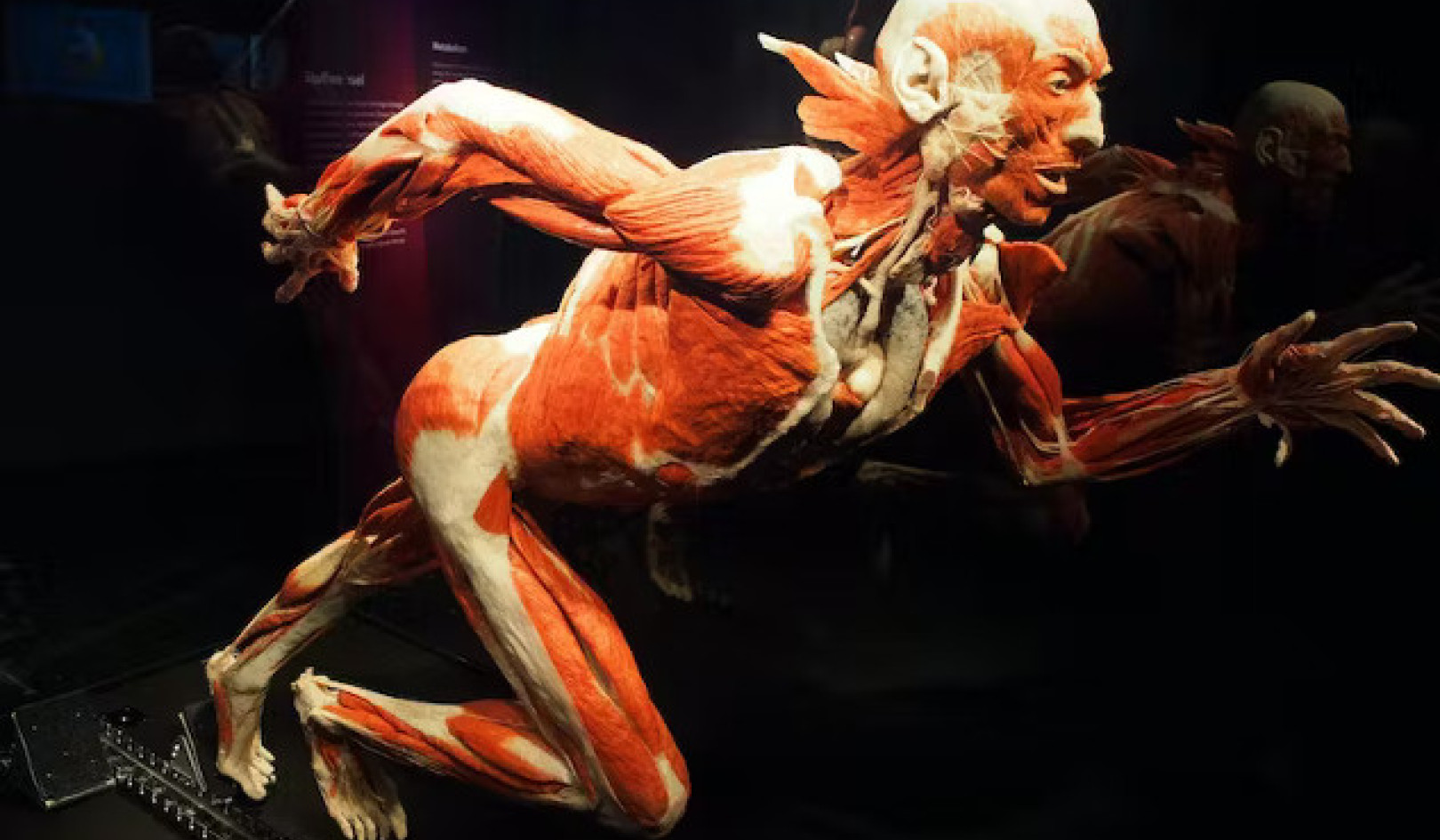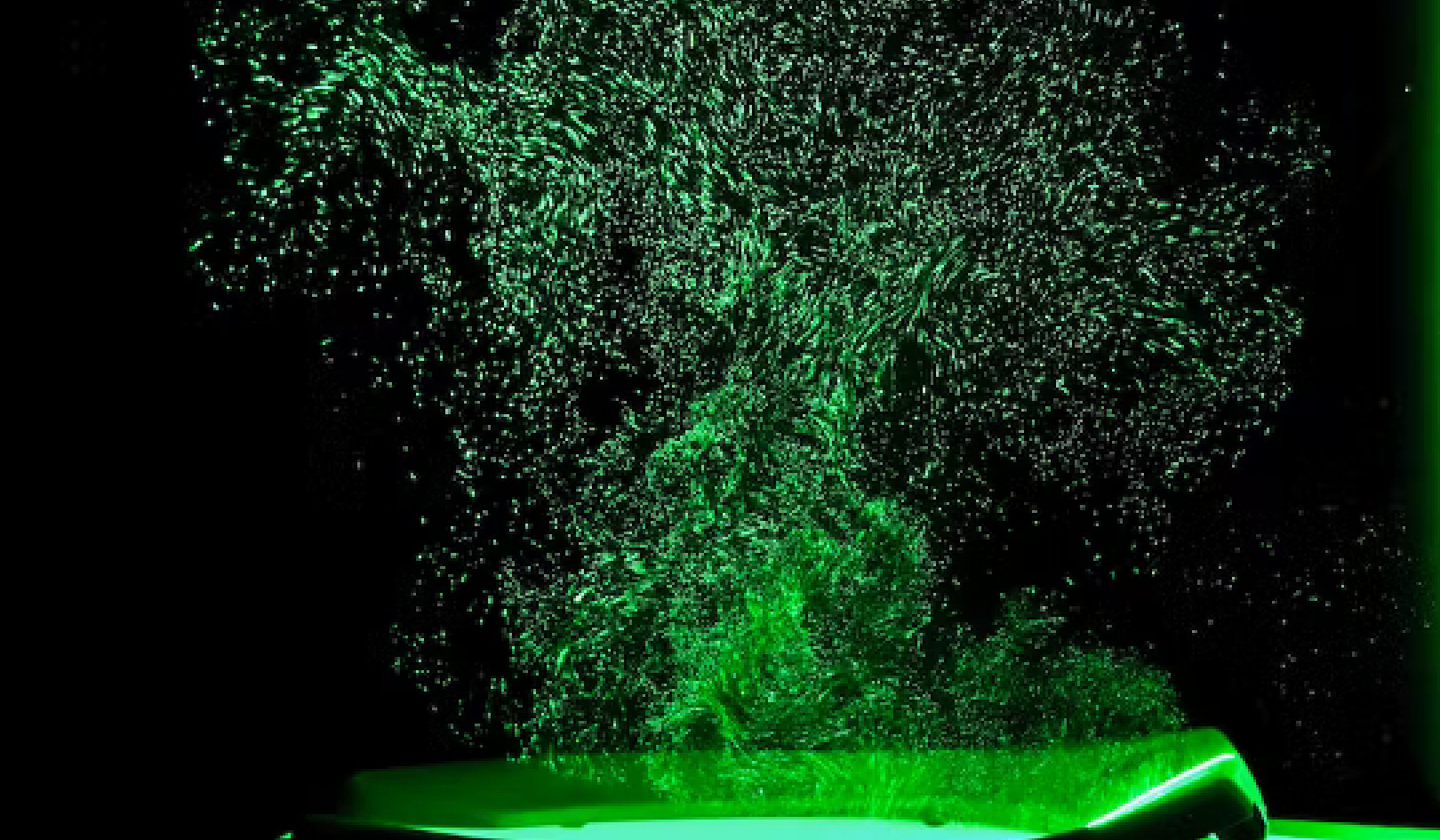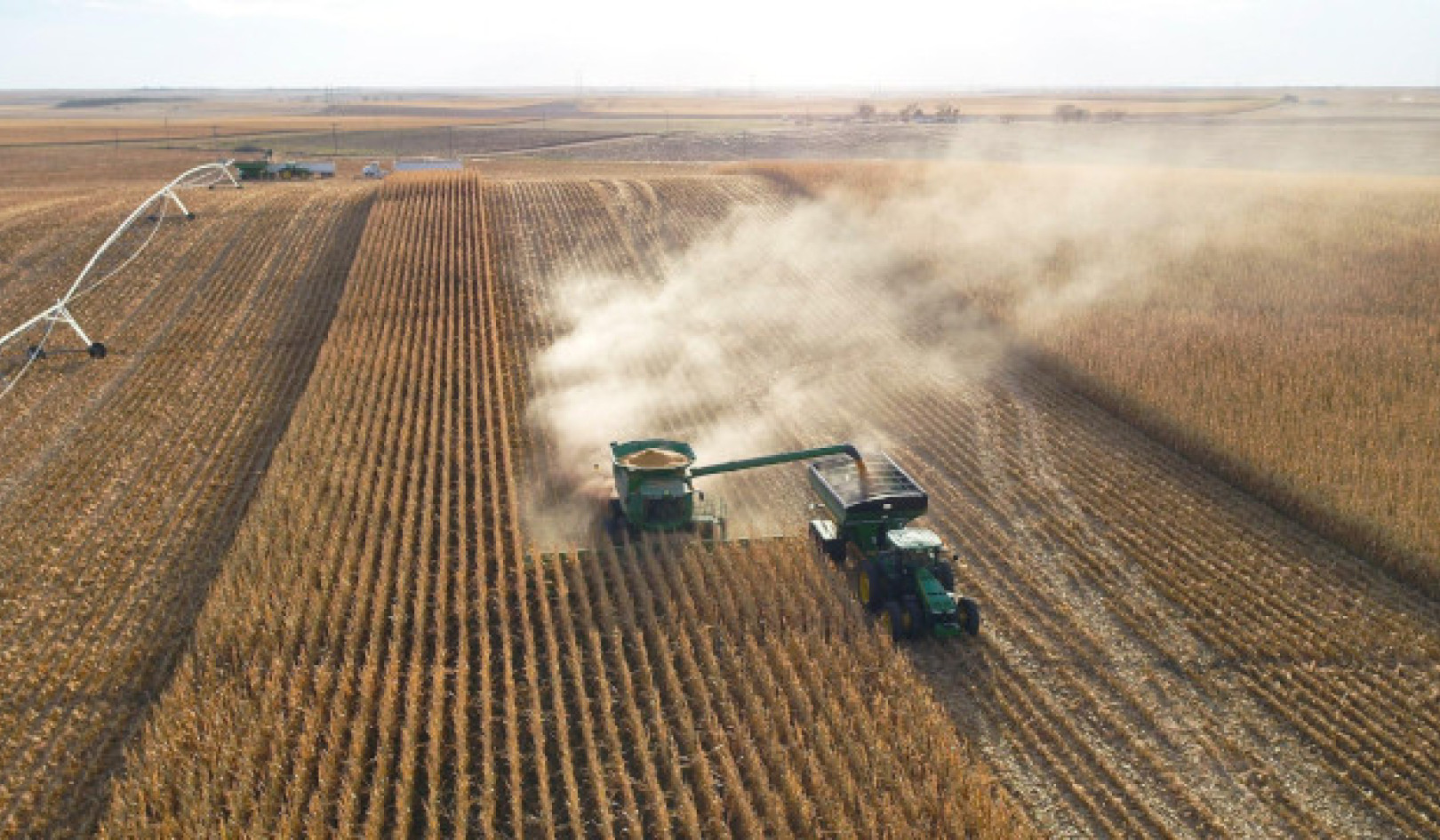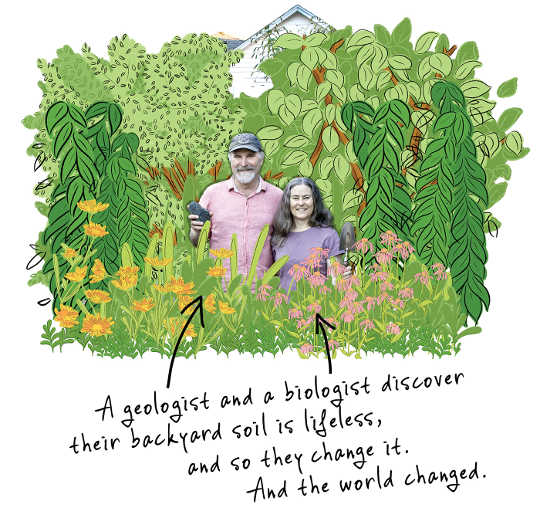
Photos by Saxon Holt. Illustrations by Enkhbayar Munkh-Erdene
When we broke ground for a garden at our 80-year-old house in the middle of Seattle, we took the most obvious thing for granted. Again and again, we crisscrossed the yard surrounding our new home, imagining where we’d plant trees to screen us from the street and neighbors. We fantasized about where we’d sit on warm summer evenings. We watched how the sun and wind moved across the yard through the seasons before choosing a place for our veggie bed. We spent months pondering every little detail, but we had overlooked the biggest one: our soil.
How did this happen to us? My realm is biology. I am the one with a bad case of plant lust, hankering to see, touch, eat, and smell all things green and rooted. Dave’s realm is geology. At the time, he was working on a book about dirt and how the plow helped bring down civilizations. Eventually, we’d travel the world to meet farmers and gardeners who were rebuilding the health and fertility of their soil. But our journey started with the dirt in our own yard. And we’d forgotten about it, until a too-hot day in mid-August.
It was 2001, and dozens of plants stood in black plastic pots scattered across the bare earth of our freshly cleared lot, baking in the sun. After a broken water line and months of delay, they needed out of their pots and into the ground.
Dave watched as the shovel I plunged into the soil stopped suddenly, sending a snap of pain into my wrist. I tried again at a different spot and the same thing happened. “Umm, how ’bout you give it a try?” I said. He dug in one spot, and then another. Each time a resounding t-i-i-i-n-g-g rang out as the shovel bounced off a shallow impenetrable layer. All our planning and now the damn dirt was on strike?
Part of our challenge was obvious. Beneath our anemic dirt, somewhere between the color of beach sand and a beat-up pair of khaki pants, lay glacial till. This was the concrete-like geology my shovel kept hitting. But perhaps the biggest problem was the dearth of life in our soil. Without this critical ingredient, we’d never have the kind of soil that would support the lush garden we dreamed about.
Through the rest of August and into fall, we struggled with planting and accepted our only option—do what we could with the soil we had. We’d never get rid of the glacial till deep down, but we could restore life to the ground above it. Imbuing our soil with life meant we needed to add dead things to it—organic matter. Soil, after all, is the gut of the Earth, and organic matter is the lifeblood that makes this great gut work.
The giants of soil life—the smooth, liver-colored earthworms and hard-bodied insects with oversized jaws—take the first run at breaking down organic matter. They grind, chomp, chew, and shred it into pieces, which feed them and smaller soil dwellers, all the way down the line to the tiniest creatures on Earth: bacteria and other microbes.
This eat-or-be-eaten world in the soil circulates the basic compounds and molecules of life from the dead to the living and back to the dead. Could we revive the creaking wheel of life beneath our feet? Could organic matter get it spinning and thrumming again?
As the aspiring gardener, I embarked on a mission to find organic matter and bring it home. The staccato bursts from an arborist’s chipper in the neighborhood put my brain into radar mode. I’d zigzag on foot toward the sounds, zeroing in on my target. I asked the arborists if they wouldn’t mind dumping their wood chips in our driveway. Most of the time this worked. They avoided disposal fees, and I got free organic matter.
My other scores included coffee grounds from nearby shops, fallen leaves from neighbors’ yards, and the occasional pile of discarded oyster or mussel shells from a friend’s dinner table. I loaded my loot into buckets and bags and packed them into our Subaru hatchback. And though we had no farm animals for manure, I scored “zoo doo,” the composted equivalent from elephants, zebras, and other herbivores at Seattle’s Woodland Park Zoo—which, luckily, is about a mile from our house.
With this bounty of organic matter, I made mulches that I layered onto all the new garden beds. Previous gardening adventures taught me how backbreaking and time-consuming it is to mix things into the soil. Plus, I wanted to cultivate soil life. The more I dug and turned the soil, the more likely I’d maim or kill earthworms and smaller organisms like beneficial nematodes and mites.
Later in our journey, we began researching the effects of gardening and agricultural practices on soil health and visiting with farmers who had cut way back on plowing and chemicals. The take-home lesson was pretty clear—and convincing. Whether it’s gardeners using shovels or farmers using discs and plows, these practices disrupt some of the grandest symbioses on the planet. For around the roots of plants growing in healthy, life-filled soils, a biological bazaar hums with activities that underpin the well-being of the botanical world.
While Anne is the chief strategist and doer in our garden, I began to observe the cumulative effects of what she was doing. One day she complained that her mulches kept disappearing. Despite the thick layers she put on top of the planting beds, they inevitably thinned out after a few months. I poked around beneath the mulch and noticed that the surface of the soil had changed to a milk-chocolate hue, no longer the light-colored dirt I remembered initially digging into. Now, a thin, dark layer at the interface of the soil and the mulch made it hard to say really where the mulch ended and the soil began.
About four years after we put the garden in, I helped Anne move some plants from one bed to another. We were surprised to find a couple of inches of dark soil in both beds, just atop the original khaki dirt. The earth had been changing right before our eyes and right under our noses—just too slowly to notice day to day.
The dark layer contained humus, a multitude of the organic compounds and molecules that are a key part of what imbues soils with fertility. The darkening color and increasing amount of humus meant that the carbon content of the soil was increasing and, with it, the fertility of our soil.
Keeping the soil covered with compost and mulch is a way to reverse a problem that has plagued societies throughout history. Time and again, from ancient Greece to the American Dust Bowl, declining soil fertility and eroding topsoil because of plowing contributed to the demise of civilizations. But it’s not just a problem of the past. North American agricultural soils have lost about half their original complement of organic matter—so far.
Yet right in our yard, Anne was solving this age-old problem, one wheelbarrow of mulch at a time. She was building new soil far faster than nature—which takes centuries to build an inch—and along with it, more and more life.
By the garden’s third year, mushrooms were popping up beneath the handsome trio of young Persian ironwoods in our side yard. Fine white mats of fungal mycelia ran through decomposing clumps of last year’s wood-chip mulch. Plump-bodied spiders spun webs that caught water droplets and transformed the garden into a magical setting on drizzly fall days. By midsummer, herds of bees and other insect pollinators bumbled around the garden and hovered over the beds to feed on flower pollen and nectar. Dragonflies patrolled, hunting for lunch.
As the garden matured, larger animals started showing up, too. Crows and Steller’s jays used their feet and beaks to unearth a smorgasbord of morsels in the mulch and soil. A rocket-fast Cooper’s hawk cruised through one fall evening and nabbed dinner—leaving behind a small pile of soft brown feathers from its prey, a smaller bird. Bandit-masked raccoons staked their claim year-round.
Restoring life to our soil gave us a ringside seat to the march of life in the rough order in which it evolved on Earth—from microbes and fungi to worms, spiders, beetles, birds, and eventually mammals. This parallel revealed how soil life forms the foundation of ecosystems on land.
With life blossoming aboveground, we turned once again to the world beneath our feet.
Understanding what drives the soil dwellers in our subterranean menagerie led us to a place called the rhizosphere. This halolike zone extends a few millimeters or so around every single root and root hair. While Anne’s mulches prevented soil erosion and fed the largest soil dwellers, we learned the tiniest creatures supplemented their mulch meals with other food.
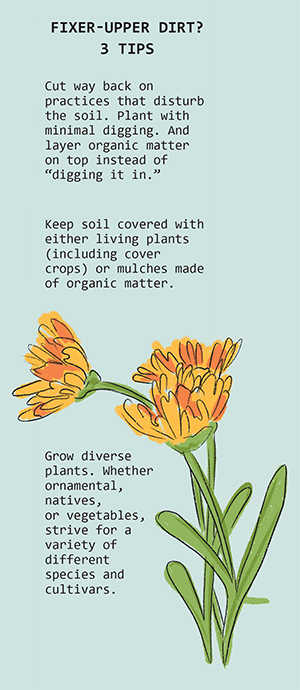 We delved into the recent research by plant scientists to learn more about the rhizosphere and the wild and alive biological bazaar within its boundaries. Bacteria and fungi flock here to dine on food that living plants ooze from their roots. The food, called exudates, is a homemade brew of nutrients including sugars, amino acids, and fats.
We delved into the recent research by plant scientists to learn more about the rhizosphere and the wild and alive biological bazaar within its boundaries. Bacteria and fungi flock here to dine on food that living plants ooze from their roots. The food, called exudates, is a homemade brew of nutrients including sugars, amino acids, and fats.
Plants run a pop-up restaurant in the soil, and, like human diners, the communities of microbes who partake need to pay for what they eat. Plants are open to different kinds of currency. Some microbes bring ready-to-go things already present in the soil, such as zinc and other mineral elements important for plant health. Others specialize in making compounds that plants need, like growth hormones, or that signal to a plant that a pathogen has entered the biological bazaar. So long as the currency translates into benefits, the botanical world serves up exudates.
The incessant exchanges of plant exudates for microbial goods also influence the nutrient profile of food crops. A well-functioning biological bazaar is key to imbuing our diet with the minerals, vitamins, and other nutrients we need for lifelong health.
What we learned got us thinking more about the soil in our vegetable bed and the kale crops it produced. By this point, the main garden was about nine years old while the vegetable beds had been in for around three years. We wondered how the nutritional quality of our greens stacked up against the USDA nutrient database, a widely used reference for standard levels of nutrients in food. We suspected that the rhizospheres of our kale plants, if their biological bazaars were thriving, would ripple through into their nutritional profiles.
We pictured bustling communities of bacteria congregating around the roots of our kale plants, lapping up exudates. Kale and other members of the cabbage family produce exudates rich in sulfur, on which certain bacteria thrive. In return, these bacteria turn phosphorus into a form that the plants can readily take up.
When we got the lab results back, we learned that our kale did pretty well. Although we hadn’t used any synthetic fertilizer containing phosphorus, the level in our kale was similar to the USDA reference value. And, in terms of calcium and zinc, our kale had twice as much as the reference value and four times the amount of folic acid.
Perhaps the most intimate relationship taking place in many biological bazaars is one where certain bacteria leave the rhizosphere and move inside of the roots of their plant host. These bacteria act like a plant’s personal chemist, converting nitrogen from the air into a form that their host can use. Abundant populations of these nitrogen-capturing bacteria can free gardeners and farmers from buying synthetic fertilizers.
Soil is often considered the most biodiverse place on the planet. A diversity of organic matter, and plant exudates, is the biggest factor for growing and maintaining soil biodiversity. And this matters—a lot. Cultivating living soil provides plants in gardens and on farms with a robust and reliable built-in health plan.
The botanical world managed to carpet the continents long before people existed. When we tapped into this ancient wisdom, we saw the common ground we shared with the first twiglike land plants. Like Anne and I, they found themselves surrounded by dirt when what they really needed was soil. The efforts of the botanical world to improve their lot in life took millions of years. Fortunately, our efforts began to bear fruit in a geological instant. Thanks to wheelbarrows full of organic matter, by the end of three growing seasons, the life of our soil was back on its proverbial feet and the transformation of our dead dirt into fertile soil was well underway.
Changing our soil changed our world. Adding organic matter stashed tons of carbon belowground. In our case, we started with about 1 percent carbon and increased it to almost 10 percent in little more than a decade. This may not sound like a big difference, but even really fertile native soils rarely contain 10 percent carbon. The additional carbon improved the fertility of our soil—and the quality of our kale.
Today our roughly 2,500-square-foot garden hosts beds for almost 30 trees, dozens of shrubs and flowering perennials, and vegetables. Come fall, the garden is a spectrum of color, from golden yellows to deep oranges, reds, and burgundy. In the summertime, we kick back on the patio enveloped by the garden. And, of course, we have a work area for storing and mixing organic matter into mulches.
Regenerating soil to change the piece of the planet where you live is possible at multiple scales. It might be a city yard like ours, rooftop garden, community garden, or working farm. Add up these efforts, and we can restore fertility to degraded soils, end hunger, and pull some carbon from the sky. Farmers can wean themselves off of agrochemicals and slash one of their biggest expenses. And we can all enjoy more life in yards, city parks, and farm fields. Cultivating living soil is something anyone can do to change the world—from the ground up.
This Article Originally Appeared On YES! Magazine
About The Authors
Anne Biklé and David R. Montgomery wrote this article for The Dirt Issue, the Spring 2019 edition of YES! Magazine. Anne and David are authors of the dirt trilogy—Dirt: The Erosion of Civilizations, The Hidden Half of Nature: The Microbial Roots of Life and Health, and Growing a Revolution: Bringing Our Soil Back to Life.
Related Books
at InnerSelf Market and Amazon





















